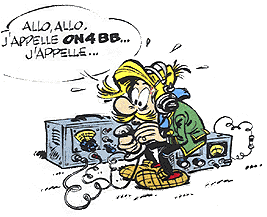Hit-A-STAR Receiver
Introduction
The goal of this site is to report my progress in building the Pic-A-STAR transceiver, the description of which is currently published as a serie of articles in RadCom, the magazine of the Radio Society of Great Britain. This transceiver design was (or should I say 'is constantly'?) developped by Peter Rhodes, G3XJP.
Pic-A-STAR is a "Software Transmitter And Receiver". At the core, it is a converter to a second IF of 15kHz (no typo!), which is fed to a DSP processor, which implements filters and detection. But Pic-A-STAR is now much more than that. The recent RadCom articles featured an H-Mode mixer, and a band-pass filter. And Peter has perhaps one or two more bunnies in his hat.
RadCom is normally only available to RSGB members.
But the past articles are available from the file section of the
Yahoo! group devoted to STAR discussions.
The serie started in August 2002 and is still going on !
Note that you will probably need the article serie about Pic'n Mix (a previous design of
Peter, on which STAR builds). The text of these articles is also available from the Pic-A-Star Yahoo! group,
but they do not contain the PCB artwork.
Alternatively, you can buy the RadCom 1999 CD-ROM archive (available from the RSGB), or you can borrow
the relevant issues of RadCom from your society library if such a service is available.
This is possible for UBA members (cf. CQ-QSO).
The site of G6AK provides PCBs to
build it, including improved versions, like the Pic Adapter needed by Pic-A-Star already included on the main board.
Imaginary FAQs
Why "Hit"-A-STAR ?
- Pic-A-STAR builds on one of Peter's previous designs, Pic'n Mix,
published in RadCom from January to May 1999. It is a DDS and a controller board driven
by a Pic. In Pic-A-STAR, the Pic of Pic'n Mix is upgraded to a more powerful version.
Although I use a similar DDS, I discarded the Pic'n Mix solution, because I wanted another controller, and a different user interface (ATM-like). The heart of my controller board is an Hitachi H8s, hence the "Hit".
Your title says "receiver" !
- The first reason is that I start this project from scratch. It is then simpler for me to build a receiver first, and to upgrade it to a transceiver later. This frees me from building a PA, an LPF, some power T/R switching device, etc...
- The second reason is that the regulations in Belgium are quite strict. You cannot build a transmitter without having first the approbation of the IBPT-BIPT (the equivalent of the RA in Great-Britain). For this, you must provide a complete description of what you want to build, including complete schematics, etc... Once the design has been approved, you can start the construction. Sorry, but I couldn't wait ;-)
If STAR stands for 'Software Transmitter And Receiver', shouldn't yours be an 'SR' ?
- Well, that wouldn't sound good, would it ?
- And, at the heart of this receiver, there's still the complete Pic-A-STAR hardware, which has all the transmitting capability, even if it won't be used in the beginning.
I'd like to contact you, but can't find your email anywhere...
- That's right. Putting your email address on a web site is a sure receipt to be flooded by spam. But as everyone registered on qsl.net, I have an address with my callsign 'at' their domain name.
Links
Where everything happens
- 3.727 MHz. Sorry, I can't provide a link for this :-)
- The Pic-A-STAR Yahoo! group
STARs
Amateur Software Transceivers
- DSP-10 by Bob Larkin, W7PUA, the inspirational source of Peter.
- SDR-1000 by Gerald Youngblood, AC5OG.
Book

This site is dedicated to André Franquin, SK